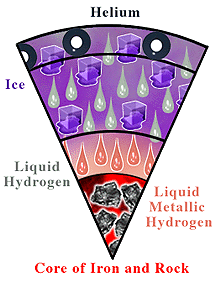The rings around Saturn have captured the imagination of humans for hundreds of years. A natural offshoot of that observation has been a desire to know what is Saturn made of. Using various methods of testing, scientists believe that Saturn is composed of 96% hydrogen, 3% helium, and 1% various trace elements that include methane, ammonia, ethane, and hydrogen deuteride. Several of these gases can be found in gas, liquid, and molten states as you descend into the planet.
The state of the gases change with pressure and temperature. At the cloud tops, you would encounter ammonia crystals, but at the bottom of the clouds you would come across ammonium hydrosulfide and/or water. Beneath the clouds, atmospheric pressure increases causing an increase in temperature, so hydrogen moves into a liquid state. Pressure and temperature continue to increase as you close in on the core, causing hydrogen to become metallic. Saturn, much like Jupiter, is thought to have a loose core made up of relatively little rock and some metals.
It is hard to conceive that Saturn is made up of much more than gas based on its low density. Saturn has a density of 0.687 g/cm3. Earth, on the other hand, has a density of 5.513 g/cm3. That means that a planet that has 95 times more mass than Earth has barely 12% of its density. Saturn’s density is so low that it could float on water more easily than most boats.
Modern space based observation has led to many discoveries about the make up of Saturn. The missions began with a flyby of the Pioneer 11 spacecraft in 1979. That mission discovered the F ring. The following year Voyager 1 flew by sending back surface details of several of Saturn’s moons. It also proved that the atmosphere on the moon Titan was impenetrable by visible light. In 1981 Voyager 2 visited Saturn and discovered changes in the atmosphere and the rings as well as confirming the presence of the Maxwell Gap and the Keeler Gap, both first seen by Voyager 1.
After Voyager 2, Cassini–Huygens spacecraft performed a Saturn orbit insertion maneuver to enter orbit around the planet in 2004. The craft had been studying the system for some time before entering orbit. The discoveries made by the craft are numerous and best explained on NASA’s mission page.
Saturn has held the imagination of countless generations. Knowing the answer to ”what is Saturn made of” is a great beginning. Hopefully, you will dive right in and become a Saturnian expert.
Here’s an article about what Saturn’s rings are made of, and information about the planet’s radiation belts.
Here’s an overview of NASA’s Cassini mission to Saturn, and the story of Saturn.
We have recorded two episodes of Astronomy Cast just about Saturn. The first is Episode 59: Saturn, and the second is Episode 61: Saturn’s Moons.
Source: NASA

